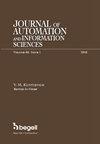INVESTIGATION OF THE GEOMETRY OF THE D-PARTITION OF ONE-DIMENSIONAL PLANE OF PARAMETER OF THE CHARACTERISTIC EQUATION OF A CONTINUOUS SYSTEM
Q3 Engineering
Journal of Automation and Information Sciences
Pub Date : 2021-07-01
DOI:10.34229/1028-0979-2021-4-12
引用次数: 0
Abstract
The paper considers two types of boundaries of the D-partition in the plane of one parameter of linear continuous systems given by the characteristic equation with real coefficients. The number of segments and intervals of stability of the X-partition curve is estimated. The maximum number of stability intervals is determined for different orders of polynomials of the equation of the boundary of the D-partition of the first kind (even order, odd order, one of even order, and the other of odd order). It is proved that the maximum number of stability intervals of a one-parameter family is different for all cases and depends on the ratio of the degrees of the polynomials of the equation of the D-partition curve. The derivative of the imaginary part of the expression of the investigated parameter at the initial point of the D-partition curve is obtained in an analytical form, the sign of which depends on the ratio of the coefficients of the characteristic equation and establishes the stability of the first interval of the real axis of the parameter plane. It is shown that for another type of the boundary of the D-partition in the plane of one parameter, there is only one interval of stability, the location of which, as for the previous type of the boundary of the stability region (BSR), is determined by the sign of the first derivative of the imaginary part of the expression of the parameter under study. Consider an example that illustrates the effectiveness of the proposed approach for constructing a BSR in a space of two parameters without using «Neimark hatching» and constructing special lines. In this case, a machine implementation of the construction of the stability region is provided. Considering that the problem of constructing the boundary of the stability region in the plane of two parameters is reduced to the problem of determining the BSR in the plane of one parameter, then the given estimates of the maximum number of stability regions in the plane of one parameter allow us to conclude about the number of maximum stability regions in the plane of two parameters, which are of practical interest. In this case, one of the parameters can enter nonlinearly into the coefficients of the characteristic equation.连续系统特征方程参数一维平面的d分割几何研究
本文考虑了由实系数特征方程给出的线性连续系统一参数平面上D部分的两类边界。估计了X分区曲线的分段数和稳定性区间。对于第一类D部分的边界的方程的多项式的不同阶数(偶数阶、奇数阶、偶数阶中的一个和奇数阶中的另一个),确定稳定区间的最大数目。证明了单参数族的稳定区间的最大个数在所有情况下都是不同的,并且取决于D部分曲线方程的多项式的次数比。所研究参数的表达式的虚部在D分割曲线初始点的导数以解析形式获得,其符号取决于特征方程的系数之比,并建立了参数平面实轴第一区间的稳定性。结果表明,对于一个参数平面中的D部分的另一种类型的边界,只有一个稳定区间,其位置与先前类型的稳定区域边界(BSR)一样,由所研究的参数表达式的虚部的一阶导数的符号确定。考虑一个示例,该示例说明了所提出的方法在两个参数的空间中构建BSR的有效性,而不使用“Neimark影线”和构建专线。在这种情况下,提供了构造稳定区域的机器实现。考虑到在两个参数的平面上构造稳定区域的边界的问题被简化为在一个参数的面上确定BSR的问题,那么给定的一个参数平面上稳定区域的最大数量的估计允许我们得出关于两个参数平面中最大稳定区域的数量的结论,具有实际意义。在这种情况下,其中一个参数可以非线性地输入到特征方程的系数中。
本文章由计算机程序翻译,如有差异,请以英文原文为准。
求助全文
约1分钟内获得全文
求助全文
来源期刊

Journal of Automation and Information Sciences
AUTOMATION & CONTROL SYSTEMS-
自引率
0.00%
发文量
0
审稿时长
6-12 weeks
期刊介绍:
This journal contains translations of papers from the Russian-language bimonthly "Mezhdunarodnyi nauchno-tekhnicheskiy zhurnal "Problemy upravleniya i informatiki". Subjects covered include information sciences such as pattern recognition, forecasting, identification and evaluation of complex systems, information security, fault diagnosis and reliability. In addition, the journal also deals with such automation subjects as adaptive, stochastic and optimal control, control and identification under uncertainty, robotics, and applications of user-friendly computers in management of economic, industrial, biological, and medical systems. The Journal of Automation and Information Sciences will appeal to professionals in control systems, communications, computers, engineering in biology and medicine, instrumentation and measurement, and those interested in the social implications of technology.
 求助内容:
求助内容: 应助结果提醒方式:
应助结果提醒方式:


